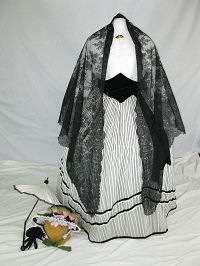1860s
In the early 1860s the black and white craze hit. This outfit consists of a white body and striped skirt. The introduction of the separate bodice made possible using the same skirt for both day and evening. The large skirts and sleeves made outdoor wear a problem solved by capes, dolmans, and shawls. Lace gave the effect of a submissive woman. Bonnets were the only acceptable form of head covering for an older woman. Parasols with folding handles made them more convenient. Fingerless mitts could be worn even while taking tea.
Elaborate petticoats could be kept in order by wearing them looped up over a pretty petticoat. Some had bright colors with velvet or embroidered trim. Skirt lifters raised the hem of the skirts from the dirt. The large skirts were also hazardous indoors, especially around the fireplaces. Regular accounts in the newspapers told of the untimely deaths of women whose light muslin garments caught fire. Fashion magazines printed methods of fire proofing these filmy gowns. The hoops made it nearly impossible to extinguish the flames should a woman’s dress catch on fire. But wearing a hoop was delightfully easy and cool compared to the heavy bulk endured by wearing four or five petticoats. Only one petticoat was needed beneath the hoop. The hoop caused women to adopt a masculine item of clothing - the drawers.
This plain gathered skirt, white with black stripes, is decorated with black velvet and galloons of heavy lace. The narrow black velvet binding around the bottom protects the hem and could be replaced when it became worn. A body (or blouse) made high at the neck with a shirred yoke, known as a Garabaldi, and could be worn with different skirts. Large puffs of silk, shirred into a narrow cuff, compose the “Bishop” sleeve. To emphasize the small waist, a black velvet “Medici” girdle was worn. The editors of Harper’s Bazaar commented “what can be more disagreeable than to see a lady’s skirt sweeping the street as she walks.”
The 1850s saw the opening of the department stores where machine made lingerie could be purchased. The sewing machine made possible more and more trimming. The expansion of wealth gave birth to a greater display by the growing middle class. Travel fever struck and months were spent planning the trip to the seaside or mountains. The first things to think about were the multitude of underclothes required. No lady would be without a wool vest next to the body to absorb perspiration even though her activities were restricted so she should not perspire. By now the drawers had evolved into split seat knee length affairs. The chemise has shrunk to hip length. The corset confined and molded the figure into the shape dictated by the fashion of the day. During the 1860s and 70s a girl of 16 should have a 20 inch waist and a woman of 20 should have a 16 inch waist. Several actresses had their floating rib removed so the waist could be drawn into those dimensions. The corset was put on damp one hour before dressing.
Click photo for detailed view.


